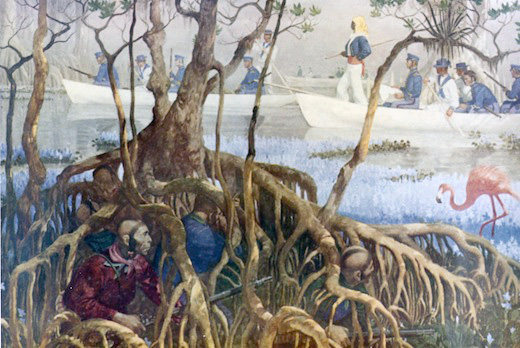
The Seminole Nation of Florida had one of the most amazing if not one of the most important alliances with freed African slaves. Many Native American Nations formed partnerships and deep relationships with African slaves. Both groups fought for freedom and the right to exist in peace, away from the colonizing forces trying to stomp them out. The rebellion of the Black Seminole nation is one of the most overlooked partnerships in Native American/African American History.
The Seminole Nation, during a period called the second Spanish period, formed a deep bond with the freed African Slaves of the coastal south, creating a mixed culture known today as Black Seminoles. In the 1680s, African slaves fled from English South Carolina to Spanish Florida seeking freedom. In 1693, King Charles II of Spain made an edict that escaped African slaves would receive freedom and protection from slave owners if they help defend the Spanish settlers at St. Augustine. Because of this partnership the freed slaves became a militia and they formed a settlement in 1738, the first legally sanctioned free African town in North America.
Because of the settlement the African slaves formed relations with the Seminole Nation. They began marrying and trading with one another, creating a new cultural identity that fused many aspects of their culture. However, even though there were some Native Seminoles and African slaves getting married and having children, the majority of Black Seminoles were not Native. The U.S. Army coined the term “Black Seminole,” but this did not stop the two groups from working with each other.
One of the things that bound the history of these two groups is both faced utter and complete obliteration. The Seminole Wars began after the American Revolution. With the U.S. slave owners winning the revolution against England, space was opened up within which other issues could be addressed, particularly issues concerning free African slaves living alongside Native Americans in Spanish Florida.
When England lost the war, they ceded to the new U.S. east and west Florida. In the 1790s, all of the freed slaves living in east or west Florida were forced back into slavery. Then there was a break in the United States effort to destroy the Black settlements.
After the War of 1812, however, General Andrew Jackson made destroying these settlements a top priority. The Native and Black communities moved to south and central Florida.
In 1820, when Spain lost the rest of Florida to the United States, many of the Black Seminoles understood that is was dangerous to remain there. In 1821, many slaves and Black Seminoles escaped to Cape Florida and the Bahamas. During this exodus many Black Seminoles were killed or taken back into slavery.
The height of this story happens during the Second Seminole War, which began in 1835. The tension between the United States and the Seminole Nation was at a high point and this was also the biggest moment for the African-Seminole alliance. In 1830, Jackson, the anti-Seminole general, was now president and he signed into law the horrific Indian Removal Act, which forced the removal of more than 4,000 Native Seminole people along with 800-plus Black Seminole allies. The Black Seminoles understood that if their Native allies were to be removed they would be forced back into slavery. So they joined forces with the militant Seminole leader Osceola. After the rebellion broke out, many Black Seminole leaders, such as John Caesar, Abraham, and John Horse, played a key role in fighting against the U.S. Army.
They recruited African slaves on plantations to fight. From the winter of 1835 to the summer of 1836 Black Seminoles, escaped slaves and Native peoples were fighting alongside one another, destroying sugar plantations and killing U.S. soldiers.
The United States government started to panic. What could be done to stop this increasingly growing and increasingly successful alliance? They came up with a plan to turn the Black Seminoles against the Native Seminoles by promising them that if they turned against their Native allies they would be granted freedom.
Very few Black Seminole took this offer. The Black Seminole alliance fought alongside the Seminole Nation until the bitter end. In 1838, over 500 Black Seminoles joined the Seminole Nation on the Trail of Tears. Many Natives, Black Natives, and Black Seminoles died on the trail. Some made it to Oklahoma, other Black Seminoles that didn’t go on the Trail of Tears fled to Mexico.
We must remember the struggles that bind us together. The story of how the Black Seminoles fought and died for freedom is something we are still fighting for today.
Photo: U.S. Marine Corp painting depicts Marines searching for Seminoles among the Everglade mangroves during the 1835-42 war (Wikimedia).










